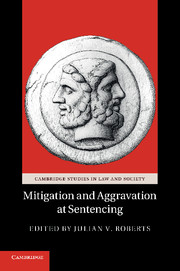Book contents
- Frontmatter
- Contents
- Tables
- Contributors
- Foreword
- Acknowledgments
- Chapter one Punishing, more or less
- Chapter two Re-Evaluating the Justifications for Aggravation and Mitigation at Sentencing
- Chapter three The Search for Principles of Mitigation
- Chapter Four Personal Mitigation and Assumptions about Offending and Desistance
- Chapter Five Intoxication as a sentencing factor
- Chapter Six Beyond the Partial Excuse
- Chapter Seven Equality before the law
- Chapter Eight Personal mitigation
- Chapter Nine Exploring Public Attitudes to Sentencing Factors in England and Wales
- Chapter Ten The Pernicious Impact of Perceived Public Opinion on Sentencing
- Chapter Eleven Addressing Problematic Sentencing Factors in the Development of Guidelines
- Chapter Twelve Proof of Aggravating and Mitigating Facts at Sentencing
- Chapter Thirteen Mitigation in Federal Sentencing in the United States
- Chapter Fourteen The discretionary effect of mitigating and aggravating factors
- Index
- References
Chapter Ten - The Pernicious Impact of Perceived Public Opinion on Sentencing
Findings from an Empirical Study of the Public’s Approach to Personal Mitigation
Published online by Cambridge University Press: 07 September 2011
- Frontmatter
- Contents
- Tables
- Contributors
- Foreword
- Acknowledgments
- Chapter one Punishing, more or less
- Chapter two Re-Evaluating the Justifications for Aggravation and Mitigation at Sentencing
- Chapter three The Search for Principles of Mitigation
- Chapter Four Personal Mitigation and Assumptions about Offending and Desistance
- Chapter Five Intoxication as a sentencing factor
- Chapter Six Beyond the Partial Excuse
- Chapter Seven Equality before the law
- Chapter Eight Personal mitigation
- Chapter Nine Exploring Public Attitudes to Sentencing Factors in England and Wales
- Chapter Ten The Pernicious Impact of Perceived Public Opinion on Sentencing
- Chapter Eleven Addressing Problematic Sentencing Factors in the Development of Guidelines
- Chapter Twelve Proof of Aggravating and Mitigating Facts at Sentencing
- Chapter Thirteen Mitigation in Federal Sentencing in the United States
- Chapter Fourteen The discretionary effect of mitigating and aggravating factors
- Index
- References
Summary
Sentencing has become harsher in recent times, particularly in the more serious cases. One cause of this shift has been public opinion. This holds true for countries around the world, including Australia and Britain. This influence has several strands and is both direct and indirect. Judges in Australia and in England and Wales have come to regard the public as being more punitive than the courts, and as wanting sentences to reflect better the seriousness of the offending and less the interests of the offender. As a consequence, in many types of case, the courts are now imposing tougher sentences. In England and Wales public opinion has had a second and indirect influence. There judges must fashion their sentences around sentencing guidelines, which are structured in terms of offence seriousness and which generally make little allowance for offenders by way of personal mitigation. The effect of these guidelines has been to consolidate the now diminished role of personal mitigation. Public opinion has played its part here in two ways. Of particular importance has been the influence on these guidelines of proportionality theory, said by von Hirsch to reflect common-sense justice (i.e. the public’s sense of justice). This theory requires commensurability between offence seriousness and sentence severity, a requirement interpreted quite strictly by the framers of the guidelines. Of secondary importance, the framers of the guidelines have commissioned research on public opinion to inform their judgements about factors relevant to sentence.
- Type
- Chapter
- Information
- Mitigation and Aggravation at Sentencing , pp. 188 - 207Publisher: Cambridge University PressPrint publication year: 2011

